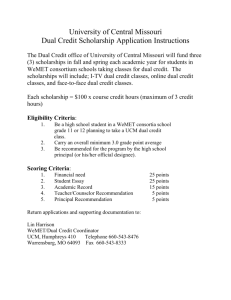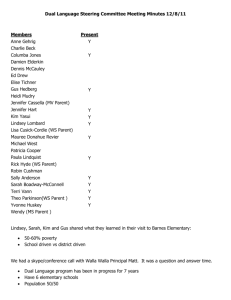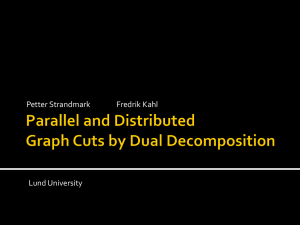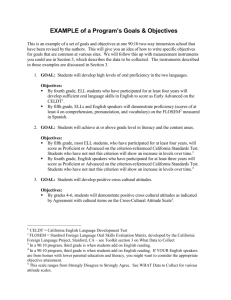Integer Programming Duality - COR@L
advertisement
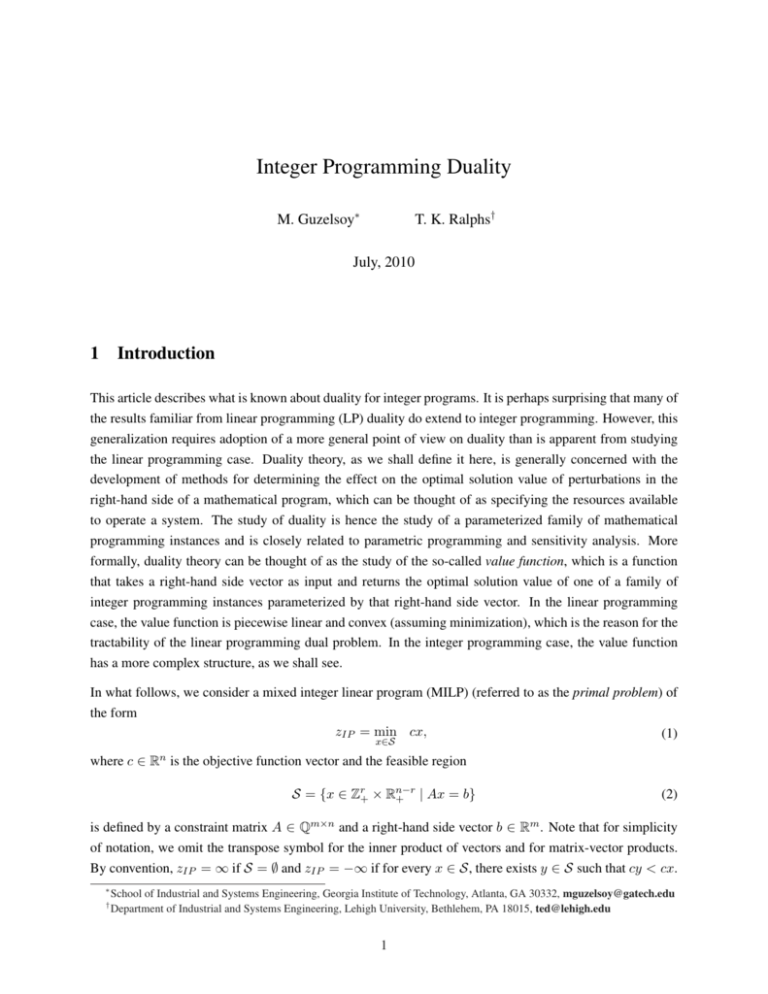
Integer Programming Duality
M. Guzelsoy∗
T. K. Ralphs†
July, 2010
1
Introduction
This article describes what is known about duality for integer programs. It is perhaps surprising that many of
the results familiar from linear programming (LP) duality do extend to integer programming. However, this
generalization requires adoption of a more general point of view on duality than is apparent from studying
the linear programming case. Duality theory, as we shall define it here, is generally concerned with the
development of methods for determining the effect on the optimal solution value of perturbations in the
right-hand side of a mathematical program, which can be thought of as specifying the resources available
to operate a system. The study of duality is hence the study of a parameterized family of mathematical
programming instances and is closely related to parametric programming and sensitivity analysis. More
formally, duality theory can be thought of as the study of the so-called value function, which is a function
that takes a right-hand side vector as input and returns the optimal solution value of one of a family of
integer programming instances parameterized by that right-hand side vector. In the linear programming
case, the value function is piecewise linear and convex (assuming minimization), which is the reason for the
tractability of the linear programming dual problem. In the integer programming case, the value function
has a more complex structure, as we shall see.
In what follows, we consider a mixed integer linear program (MILP) (referred to as the primal problem) of
the form
zIP = min cx,
(1)
x∈S
where c ∈
Rn
is the objective function vector and the feasible region
S = {x ∈ Zr+ × Rn−r
| Ax = b}
+
(2)
is defined by a constraint matrix A ∈ Qm×n and a right-hand side vector b ∈ Rm . Note that for simplicity
of notation, we omit the transpose symbol for the inner product of vectors and for matrix-vector products.
By convention, zIP = ∞ if S = ∅ and zIP = −∞ if for every x ∈ S, there exists y ∈ S such that cy < cx.
∗
†
School of Industrial and Systems Engineering, Georgia Institute of Technology, Atlanta, GA 30332, mguzelsoy@gatech.edu
Department of Industrial and Systems Engineering, Lehigh University, Bethlehem, PA 18015, ted@lehigh.edu
1
The goal is to determine zIP and an optimal solution x∗ such that cx∗ = zIP (if zIP is finite), where cx is
the solution value of x ∈ S. The variables indexed by the set I = {1, . . . , r} ⊆ N = {1, . . . , n} (if r > 0,
otherwise I = ∅) are the integer variables and the remaining variables, indexed by the set C = N \I, are
the continuous variables. The LP obtained from a given MILP by removing the integrality requirements on
the variables, i.e., setting r = 0, is referred to as the associated LP relaxation. Similarly, the associated pure
integer linear program (PILP) is obtained by requiring all variables to be integer, i.e., setting r = n.
By parameterizing (1), we obtain the value function z : Rm → R ∪ {±∞} defined as
z(d) = min cx,
x∈S(d)
(3)
where, for a given d ∈ Rm , S(d) = {x ∈ Zr+ × Rn−r
| Ax = d}. A dual function F : Rm →R ∪ {±∞} is
+
a function that bounds the value function over the set Rm , that is,
F (d) ≤ z(d) ∀d ∈ Rm .
(4)
Dual functions and methods for constructing them are the central focus of duality theory. The aim in constructing a dual function F is for it to closely approximate the value function z. In particular, we usually
want a dual function whose value at b is as close as possible to z(b). The most general form of the dual
problem is then
zD = max {F (b) : F (d) ≤ z(d), d ∈ Rm , F : Rm →R},
(5)
which is an optimization problem over the space of dual functions. We call F a weak dual function if it is
feasible for (5), i.e., it satisfies (4), and a strong dual function with respect to b if it is optimal for (5), i.e.,
satisfies F (b) = z(b). Note that we allow only real-valued functions, so that (5) is infeasible if zIP = −∞
and zD ≤ zIP otherwise. If zIP is finite, the value function itself (or a real-valued extension of it) is a strong
dual function, i.e., zD = zIP .
Example 1 Consider the following MILP instance with a fixed right-hand side b
min 3x1 + 72 x2 + 3x3 + 6x4 + 7x5
s.t 6x1 + 5x2 − 4x3 + 2x4 − 7x5 = b and
x1 , x2 , x3 ∈ Z+ , x4 , x5 ∈ R+ .
(6)
The value function z of this sample problem together with dual functions F1 and F2 are given in Figure
1. Note that the value function is better approximated by F1 for right-hand side values b > 0 and by F2
otherwise. In addition, observe that the dual functions are strong for a subset of right-hand side values and
weak otherwise.
2
Properties of the Value Function
The study of duality begins with the study of the value function itself. In particular, we want to know what
the structure of the value function is and to what class of functions it may belong. Our fist observation is
2
z
F1
F2
18
16
14
12
10
8
6
4
2
d
-16
-14
-12
-10
-8
-6
-4
-2
0
2
4
6
8
10
12
14
16
18
20
22
24
26
28
Figure 1: The value function and sample dual functions for (6).
that the value function is subadditive. A function F is subadditive over a domain Θ if F (λ1 ) + F (λ2 ) ≥
F (λ1 + λ2 ) for all λ1 , λ2 , λ1 + λ2 ∈ Θ. The value function itself is subadditive over the domain Ω = {d ∈
Rm | S(d) 6= ∅}. To see why, let d1 , d2 ∈ Ω and suppose z(di ) = cxi for some xi ∈ S(di ), i = 1, 2. Then,
x1 + x2 ∈ S(d1 + d2 ) and hence z(d1 ) + z(d2 ) = c(x1 + x2 ) ≥ z(d1 + d2 ). Subadditivity reflects the
intuitively natural property of increasing returns to scale that we expect the value function to have.
For PILPs, Blair and Jeroslow [1982] showed that a procedure similar to Gomory’s cutting plane procedure
can be used to construct the value function in a finite number of steps, although the representation from this
procedure may have exponential size. They were thus able to characterize the class of functions to which
value functions belong, namely, Gomory functions, a subset of a more general class called Chvátal functions.
Definition 1 Let Lm = {f : Rm →R | f is linear}. Chvátal functions are the smallest set of functions C
such that
1. If h ∈ Lm , then h ∈ C .
2. If h1 , h2 ∈ C and α, β ∈ Q+ , then αh1 + βh2 ∈ C .
3. If h ∈ C , then dhe ∈ C .
Gomory functions are the smallest set of functions G ⊆ C with the additional property that
4. If h1 , h2 ∈ G , then max{h1 , h2 } ∈ G .
Note that both Chvátal and Gomory functions are subadditive and every Gomory function can be written as
the maximum of finitely many Chvátal functions. Blair and Jeroslow [1982] show for a PILP in the form
(1) with z(0) = 0 that (i) the value function over the domain Ω is a Gomory function and (ii) there always
exists an optimal solution to the dual problem (5) that is a Chvátal function.
For MILPs, Blair and Jeroslow [1984] argue that the value function can still be represented by a Gomory
function if cj = 0 ∀j ∈ C or can be written as a minimum of finitely many Gomory functions. A deeper
3
result is contained in the subsequent work of Blair [1995], who showed that the value function of an MILP
can be written as a Jeroslow formula, consisting of a Gomory function and a correction term. For a given
d ∈ Ω, let the set E consist of the index sets of dual feasible bases of the linear program
min{cC xC : AC xC = d, x ≥ 0}.
(7)
j
m
j
By the rationality of A, we can choose M ∈ Z+ such that M A−1
E a ∈ Z for all E ∈ E , j ∈ I, where a
is the j th column of A. For E ∈ E, let vE be the corresponding basic feasible solution to the dual of
min{
1
1
cC xC :
AC xC = d, x ≥ 0},
M
M
(8)
which is a scaled version of (7). Finally, for a right-hand side d and E ∈ E, let bdcE = AE bA−1
E dc.
Theorem 2 (Blair [1995]) For the MILP (1), there is a g ∈ G such that
z(d) = min g(bdcE ) + vE (d − bdcE )
E∈E
(9)
for all d ∈ Ω.
3
The Subadditive Dual
The dual (5) is rather general, so a natural question is whether it is possible to restrict the space of functions
in order to obtain a tractable method for constructing a strong dual function. Note that
F (d) ≤ z(d), d ∈ Rm ⇐⇒ F (d) ≤ cx , x ∈ S(d), d ∈ Rm
n−r
⇐⇒ F (Ax) ≤ cx , x ∈ Zr+ × R+
.
(10)
Restricting F to be linear, (5) reduces to max{vb | vA ≤ c, v ∈ Rm } by (10), which is the dual of
the LP relaxation of the original MILP. Jeroslow [1979] showed that restricting the search space to only
convex functions also results in the same optimal solution value obtained in the linear case. Therefore, these
restrictions result in a dual that is no longer guaranteed to produce a strong dual function.
Johnson [1973, 1974, 1979] and later Jeroslow [1978] developed the idea of restricting the search space to a
certain subset of subadditive functions. It is clear that this restriction retains the desirable property of strong
duality, since the value function is itself subadditive over Ω.
From (10), if we set Γm ≡ {F : Rm →R |F (0) = 0, F is subadditive}, then we can rewrite (5) as the
subadditive dual
zD = max
F (b)
F (aj ) ≤ cj
j
F̄ (a ) ≤ cj
F ∈ Γm ,
4
∀j ∈ I,
∀j ∈ C, and
(11)
where the function F̄ is the upper d-directional derivative of F at zero and is defined by
F̄ (d) = lim sup
δ→0+
F (δd)
∀d ∈ Rm .
δ
(12)
Intuitively, the role of F̄ in (11) is to ensure that solutions to (11) have gradients that do not exceed those of
the value function near zero, since the subadditivity of F alone is not enough to ensure this in the case of
MILP.
The main results concerning the relationship between the primal and dual problems in LP duality can be
generalized to the MILP case.
Theorem 3 For the primal problem (1) and its subadditive dual (11), the following statements hold:
1. (Weak Duality by Jeroslow [1978, 1979]) Let x be a feasible solution to the primal problem and let F
be a feasible solution to the subadditive dual. Then, F (b) ≤ cx .
2. If the primal problem (resp., the dual) is unbounded then the dual problem (resp., the primal) is
infeasible.
3. If the primal problem (resp., the dual) is infeasible, then the dual problem (resp., the primal) is infeasible or unbounded.
4. (Strong duality by Jeroslow [1978, 1979], Wolsey [1981]) If the primal problem (resp., the dual) has
a finite optimum, then so does the dual problem (resp., the primal) and they are equal.
The proof of weak duality and the associated results follow directly from the construction of dual problem.
However, in order to show strong duality holds for the case where Ω ⊂ Rm , we need an additional result of
Blair and Jeroslow [1977], which states that any given MILP can be “extended” to one that is feasible for
all right-hand sides and whose value function agrees with that of the original MILP for all right-hand sides
d ∈ Ω.
Example 2 For the MILP (6), the subadditive dual problem is
max
F (b)
F (6)
F (5)
F (−4)
F̄ (2)
F̄ (−7)
F
≤3
≤ 72
≤3 .
≤6
≤7
∈ Γ1 .
(13)
Note from Figure 1 that F2 (d) = max{ d2 , − 3d
4 } ∀d ∈ R is feasible to dual problem and furthermore, optimal
for the right-hand side values b ∈ {. . . , −8, −4, 0, 6, 12, . . . }.
5
The subadditive dual (11) can also be used to extend familiar concepts such as reduced costs and the complementary slackness conditions to MILPs. For a given optimal solution F ∗ to (11), the reduced costs can
be defined as cj − F ∗ (aj ) for j ∈ I and cj − F̄ ∗ (aj ) for j ∈ C. These reduced costs have an interpretation
similar to that in the LP case, except that we do not have the same concept of “sensitivity ranges” within
which the computed bounds are exact. On the other hand, complementary slackness conditions, if satisfied,
yield a certificate of optimality for a given primal-dual pair of feasible solutions and can be stated as follows.
Theorem 4 (Jeroslow [1978], Johnson [1979], Bachem and Schrader [1980], Wolsey [1981]) For a given
right-hand side b, let x∗ and F ∗ be feasible solutions to to the primal problem (1) and the subadditive dual
problem (11). Then, x∗ and F ∗ are optimal if and only if
x∗j (cj − F ∗ (aj )) = 0, ∀j ∈ I,
x∗j (cj − F̄ ∗ (aj )) = 0, ∀j ∈ C, and
X
X
F̄ ∗ (aj )x∗j .
F ∗ (b) =
F ∗ (aj )x∗j +
j∈I
(14)
j∈C
The subadditive duality framework also allows the use of subadditive functions to obtain inequalities valid
for the convex hull of the feasible region. It is easy to see that for any d ∈ Ω and F ∈ Γm with F̄ (aj ) <
∞ ∀j ∈ C, the inequality
X
X
F (aj )xj +
F̄ (aj )xj ≥ F (d)
(15)
j∈I
j∈C
is satisfied for all x ∈ S(d). Using this property, Johnson [1973] and later Jeroslow [1978] showed that any
valid inequality for S(d) is either equivalent to or dominated by an inequality in the form of (15).
As an extension to this result, Bachem and Schrader [1980] showed that the convex hull of S(d) can be
represented using only subadditive functions and that rationality of A is enough to ensure the existence of
such a representation, even if the convex hull is unbounded. For a fixed right-hand side, it is clear that
only finitely many subadditive functions are needed to obtain a complete description, since every rational
polyhedron has finitely many facets. In addition, Wolsey [1979] showed that for PILPs, there exists a finite
representation that is valid for all right-hand sides.
Theorem 5 (Wolsey [1979]) For a PILP in the form (1), there exist finitely many subadditive functions
Fi , i = 1, . . . , k, such that
n
X
conv(S(d)) = {x :
Fi (aj )xj ≥ Fi (d), i = 1, . . . , k, x ≥ 0}
(16)
j=1
for any d ∈ Ω .
4 Constructing Dual Functions
Dual functions can be grouped into three categories: (1) those obtained from known families of relaxations,
(2) those obtained as a by-product of a primal solution algorithm, such as branch-and-bound, and (3) those
6
constructed explicitly in closed form using a finite procedure.
Cutting Plane Method. Cutting plane algorithms are a broad class of methods for obtaining lower bounds
on the optimal solution value of a given MILP by iteratively generating inequalities (called cutting planes
or cuts) valid for the convex hull of S. In iteration k, the algorithm solves the following linear program:
min cx
s.t. Ax = b
Πx ≥ Π0
x ≥ 0,
(17)
where Π ∈ Rk×n and Π0 ∈ Rk represents the cutting planes generated so far. The LP dual of (17), i.e.,
max
vb + wΠ0
vA + wΠ ≤ c
(18)
v ∈ Rm , w ∈ Rk+ ,
is also a dual problem for the original primal MILP. Assuming that a subadditive representation (15) of each
cut is known, the ith cut can be expressed parametrically as a function of the right-hand side d ∈ Rm in the
form
X
X
Fi (σi (aj ))xj +
F̄i (σ̄i (aj ))xj ≥ Fi (σi (d)),
(19)
j∈I
j∈C
where Fi is the subadditive function representing the cut, and the functions σi , σ̄i : Rm →Rm+i−1 are
defined by
• σ1 (d) = σ̄1 (d) = d,
• σi (d) = [ d F1 (σ1 (d)) . . . Fi−1 (σi−1 (d)) ] for i ≥ 2, and
• σ̄i (d) = [ d F̄1 (σ̄1 (d)) . . . F̄i−1 (σ̄i−1 (d)) ] for i ≥ 2.
Furthermore, if (v k , wk ) is a feasible solution to (18) in the k th iteration, then the function
k
FCP (d) = v d +
k
X
wik Fi (σi (d))
(20)
i=1
is a feasible solution to the subadditive dual problem (11).
Wolsey [1981] showed how to construct a dual function optimal to the subadditive dual for a given PILP
using the Gomory fractional cutting plane algorithm under the assumption that cuts are generated using
a method guaranteed to yield a sequence of LPs with lexicographically increasing solution vectors (this
method is needed to guarantee termination of the algorithm in a finite number of steps with either an optimal
7
solution or a proof that the original problem is infeasible). In Gomory’s procedure, the subadditive function
Fi , generated for iteration i, has the following form
&m
'
i−1
X
X
i−1
i−1
i−1
Fi (d) =
λk dk +
λm+k Fk (d) where λi−1 = (λ1i−1 , . . . , λm+i−1
) ≥ 0.
(21)
k=1
k=1
Assuming that b ∈ Ω, z(b) > −∞, and that the algorithm terminates after k iterations, the function FG
defined by
k
X
k
FG (d) = v d +
wik Fi (d)
(22)
i=1
is optimal to the subadditive dual problem (11).
In practice, it is generally not computationally feasible to determine a subadditive representation for each
cut added to the LP relaxation. An alternative approach that is feasible for some classes of valid inequalities
is simply to track the dependency of each cut on the original right-hand side in some other way. As an
example of this, Schrage and Wolsey [1985] showed how to construct a function tracking dependency on
the right-hand side for cover inequalities by expressing the right-hand side of a cut of this type as an explicit
function of the right-hand side of the original knapsack constraint.
Corrected Linear Dual Functions. A natural way in which to account for the fact that linear functions are
not sufficient to yield strong dual functions in the case of MILPs is to consider dual functions that consist of
a linear term (as in the LP case) and a correction term accounting for the duality gap. One way to construct
such a function is to consider the well-known group relaxation. Let B be the index set of the columns of
a dual feasible basis for the LP relaxation of a PILP and denote by N \B the index set of the remaining
columns. Consider the function FB defined as
FB (d) = min cB xB + cN \B xN \B
s.t AB xB + AN \B xN \B = d
n−m
xB ∈ Zm , xN \B ∈ Z+
.
(23)
−1
Substituting xB = A−1
B d − AB AN \B xN \B in the objective function, we obtain the group relaxation (Gomory [1969])
FB (d) = cB A−1
B d − max c̄N \B xN \B
(24)
AB xB + AN \B xN \B = d
n−m
xB ∈ Zm , xN \B ∈ Z+
,
where c̄N \B = (cB A−1
B AN \B − cN \B ). Here, dual feasibility of the basis AB is required to ensure that
c̄N \B ≤ 0.
Note that FB is subadditive and hence feasible to the subadditive dual (11). Observe that FB (b) = z(b)
when there exists an optimal solution to (24) with xB ≥ 0.
Another way to construct an optimal solution to the subadditive dual using a linear function with a correction
term is given by Klabjan [2002].
8
Theorem 6 (Klabjan [2002]) For a PILP in the form (1), and a given vector v ∈ Rm , define the function
Fv as
|D |
Fv (d) = vd − max{(vADv − cDv )x | ADv x ≤ d, x ∈ Z+ v },
(25)
where Dv = {j ∈ I : vaj > cj }. Then, Fv is a feasible solution to the subadditive dual problem (11) and
furthermore, if b ∈ Ω and z(b) > −∞, there exists a v ∈ Rm such that Fv (b) = z(b).
Klabjan [2002] also introduced an algorithm that finds the optimal dual function utilizing a subadditive
approach from (Burdet and Johnson [1977]) together with a row generation approach that requires the enumeration of feasible solutions.
Lagrangian Relaxation.
A mathematical program obtained by relaxing and subsequently penalizing
the violation of a subset of the original constraints, called the complicating constraints, is a Lagrangian
relaxation (Fisher [1981]). Suppose for a given d ∈ Rm that the inequalities defined by matrix A and
right-hand side d are partitioned into two subsets defined by matrices A1 and A2 and right-hand sides d1
and d2 . Furthermore, let SLD (d1 ) = {x ∈ Zr+ × Rn−r
: A1 x = d1 }. Then, for a given penalty multiplier
+
v ∈ Rm−l , the corresponding Lagrangian relaxation can be formulated as
L(d, v) =
min
x∈SLD
(d1 )
cx + v(d2 − A2 x).
(26)
Assuming z(0) = 0 and that x∗ (d) is an optimal solution to the original MILP with right-hand side d, we
have L(d, v) ≤ cx∗ (d) + v(d2 − A2 x∗ (d)) = cx∗ (d) = z(d) ∀ v ∈ Rm−l . Thus, the Lagrangian function
defined by
LD (d) = max {L(d, v) : v ∈ V },
(27)
with V ≡ Rm−l , is a feasible dual function in the sense that LD (d) ≤ z(d) ∀d ∈ Ω. Observe that for a
given d ∈ Ω, L(d, v) is a concave, piecewise-polyhedral function.
LD above is a weak dual function in general, but Blair and Jeroslow [1979] showed that it can be made
strong for PILP problems by introducing a quadratic term.
Theorem 7 (Blair and Jeroslow [1979]) For a PILP in the form (1), denote the quadratic Lagrangian dual
function as
LD (d, v) = max L(d, v, ρ),
(28)
ρ∈R+
with
L(d, v, ρ) = minn {(c − vA)x + ρ
x∈Z+
m
X
(Ai x − di )2 + vd},
(29)
i=1
where v ∈ Rm , ρ ∈ R+ and Ai is the ith row of A. Then for a given v ∈ Rm , LD (d, v) ≤ z(d) ∀d ∈ Ω.
Furthermore, if b ∈ Ω and z(b) > −∞, then for any v ∈ Rm , LD (b, v) = z(b).
9
Branch and Bound. Let us assume now that the MILP (1) has a finite optimum and has been solved to
optimality by a branch-and-bound algorithm. Let T be the set of leaf nodes of the resulting search tree. To
obtain a bound for the node t ∈ T , we solve the LP relaxation of the following problem
z t (b) = min cx
s.t. Ax
x
−x
x
=
≥
≥
∈
b
lt
−ut
Zr × Rn−r ,
(30)
where ut , lt ∈ Zn+ are the branching bounds applied only to the integer variables.
For each feasibly pruned node t ∈ T , let (v t , v t , v t ) be the corresponding solution to the dual of the LP
relaxation used to obtain the bound that allowed the pruning of node t. Note that such a solution is always
available if the LP relaxations are solved using a dual simplex algorithm. For each infeasibly pruned node
t ∈ T , let (v t , v t , v t ) be a corresponding dual feasible solution with v t b + v t lt − v t ut ≥ z(b) that can
be obtained from the dual solution of the parent of node t and a dual ray that makes the dual problem
unbounded.
Theorem 8 (Wolsey [1981]) If b ∈ Ω and z(b) > −∞, then the function
FBC (d) = min{v t d + v t lt − v t ut }
(31)
t∈T
is an optimal solution to the dual (5).
Note that it is also possible to consider the dual information revealed by the intermediate tree nodes. Schrage
and Wolsey [1985] give a recursive algorithm to evaluate a dual function that approximates the value function
better by considering the relations between intermediate nodes and their offsprings.
Generating Functions. Lasserre [2005a,b] introduced a different method for constructing the value function of PILPs that utilizes generating functions. This methodology does not fit well into a traditional duality
framework, but nevertheless gives some perspective about the role of basic feasible solutions of the LP
relaxation in determining the optimal solution of a PILP.
Theorem 9 (Lasserre [2009]) For a PILP in the form (1) with A ∈ Zm×n , define
z(d, c) = min cx,
(32)
x∈S(d)
and let the corresponding summation function be
ẑ(d, c) =
X
ecx ∀d ∈ Zm .
(33)
x∈S(d)
Then the relationship between z and ẑ is
1
ln ẑ(d, qc).
q→−∞ q
ez(d,c) = lim ẑ(d, qc)1/q or equivalently, z(d, c) = lim
q→−∞
10
(34)
A closed form representation of ẑ can be obtained by solving the two sided Z - transform F̂ : Cm →C
defined by
n
X
Y
1
F̂ (s, c) =
,
(35)
s−d ẑ(d, c) =
cj s−aj
1
−
e
m
j=1
d∈Z
with sd = sd11 . . . sdmm for d ∈ Zm and where the last equality is obtained by applying Barvinok [1993]’s
short form equation for summation problems over the domain of integral points. This equality is well-defined
j
if |sa | > ecj , j = 1, . . . , n and the function ẑ is then obtained by solving the inverse problem
Z
Z
1
m
F̂ (s, c)sd−1 ds,
(36)
ẑ(d, c) =
.
.
.
(2iπ)m |s1 |=γ1
|sm |=γm
j
where γ is a vector satisfying γ a > ecj j = 1, . . . , n and 1m = (1, . . . , 1) ∈ Rm .
Although it is possible to solve (36) directly by Cauchy residue techniques, the complex poles make it difficult. One alternative is to apply Brion and Vergne’s (see Brion and Vergne [1997], Lasserre [2009] for
details) lattice points counting formula in a polyhedron to get the reduced form, which, for each d ∈ Rm , is
composed of the optimal solution value of the LP relaxation and a correction term. The correction term is
the minimum of the sum of the reduced costs of certain nonbasic variables over all basic feasible solutions,
obtained by the degree sum of certain real-valued univariate polynomials. Another approach using generating functions is to apply Barvinok [1994]’s algorithm for counting lattice points in a polyhedron of fixed
dimension to a specially constructed polyhedron that includes for any right-hand side the corresponding
minimal test set (see Loera et al. [2004a,b] for details).
5
Conclusion
Considering the fact that computing the value function for just a single right-hand side is an NP-hard optimization problem in general, computing the value function must necessarily be extremely difficult. The
theory of duality, in turn, enables us to derive tractable methods for generating dual functions that approximate the value function and are at the core of a variety of MILP optimization algorithms including sensitivity
analysis, warm starting, stochastic and multilevel programming algorithms.
It has so far been difficult to replicate for integer programming the functional and efficient implementations
of dual methods we have become so accustomed to in the linear programming case. However, with recent
advances in computing, an increased attention is being devoted to integer programming duality in the hope
that new computational tools can contribute to more successful implementations.
References
A. Bachem and R. Schrader. Minimal equalities and subadditive duality. Siam J. on Control and Optimization, 18(4):437–443, 1980.
11
A.I. Barvinok. Computing the volume, counting integral points, and exponential sums. Discrete Comput.
Geom., 10:1–13, 1993.
A.I. Barvinok. Polynomial time algorithm for counting integral points in polyhedra when the dimension is
fixed. Math of Operations Research, 19:769–779, 1994.
C.E. Blair. A closed-form representation of mixed-integer program value functions. Mathematical Programming, 71:127–136, 1995.
C.E. Blair and R.G. Jeroslow. The value function of a mixed integer program: I. Discrete Mathematics, 19:
121–138, 1977.
C.E. Blair and R.G. Jeroslow. The value function of a mixed integer program: II. Discrete Mathematics, 25:
7–19, 1979.
C.E. Blair and R.G. Jeroslow. The value function of an integer program. Mathematical Programming, 23:
237–273, 1982.
C.E. Blair and R.G. Jeroslow. Constructive characterization of the value function of a mixed-integer program: I. Discrete Applied Mathematics, 9:217–233, 1984.
M. Brion and M. Vergne. Residue formulae, vector partition functions and lattice points in rational polytopes. Journal of the American Mathematical Society, 10:797–833, 1997.
C. Burdet and E.L. Johnson. A subadditive approach to solve integer programs. Annals of Discreet Mathematics, 1:117–144, 1977.
M. L. Fisher. The lagrangian relaxation method for solving integer programming problems. Management
Science, 27:1–17, 1981.
R.E. Gomory. Some polyhedra related to combinatorial problems. Linear Algebra and Its Applications, 2:
451–558, 1969.
R.G. Jeroslow. Cutting plane theory: Algebraic methods. Discrete Mathematics, 23:121–150, 1978.
R.G. Jeroslow. Minimal inequalities. Mathematical Programming, 17:1–15, 1979.
E.L. Johnson. Cyclic groups, cutting planes and shortest paths. in Mathematical Programming, T.C. Hu and
S.M. Robinson (eds.) Academic Press, New York, NY, pages 185–211, 1973.
E.L. Johnson. On the group problem for mixed integer programming. Mathematical Programming Study,
2:137–179, 1974.
E.L. Johnson. On the group problem and a subadditive approach to integer programming. Annals of Discreet
Mathematics, 5:97–112, 1979.
12
D. Klabjan. A new subadditive approach to integer programming: Theory and algorithms. In Proceedings of the Ninth Conference on Integer Programming and Combinatorial Optimization, pages 384–400,
Cambridge,MA, 2002.
J.B. Lasserre. Duality and farkas lemma for integer programs. In Optimization : Structure and Applications,
E. Hunt and C.E.M. Pearce, eds.,, Applied Optimization Series, Kluwer Academic Publishers, 2009.
J.B. Lasserre. Generating functions and duality for integer programs. Discrete Optimization, 2(1):167–187,
2005a.
J.B. Lasserre. Integer programming, duality and superadditive functions. Contemporary Mathematics, 374:
139–150, 2005b.
J. De Loera, D. Haws, R. Hemmecke, P. Huggins, B. Sturmfels, and R. Yoshida. Short rational functions
for toric algebra and applications. J. Symbolic Comp., 38:959–973, 2004a.
J. De Loera, D. Haws, R. Hemmecke, P. Huggins, and R. Yoshida. Three kinds of integer programming
algorithms based on barvinok’s rational functions. 10th International IPCO Conference. Lecture Notes in
Computer Science, 3064:244–255, 2004b.
L. Schrage and L.A. Wolsey. Sensitivity analysis for branch and bound integer programming. Operations
Research, 33(5):1008–1023, 1985.
L.A. Wolsey. The b-hull of an integer program. London School of Economics and CORE, 1979.
L.A. Wolsey. Integer programming duality: Price functions and sensitivity analysis. Mathematical Programming, 20:173–195, 1981.
13


